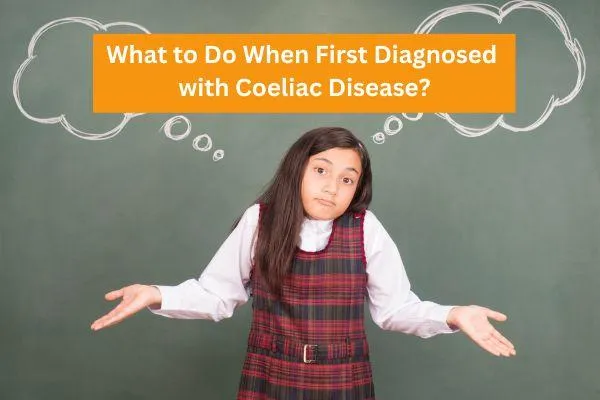Gluten Free Stories

What to Do When First Diagnosed with Coeliac Disease?
If you’ve recently been diagnosed with coeliac disease, you might be wondering, “What do I do now?” Trust me, I’ve been there.
I was diagnosed 25 years ago, and while it was overwhelming at first, learning to live gluten free has transformed my life for the better. I still feel so relieved, that this particular autoimmune condition can be managed by food and not medication.
If you’re feeling a mix of emotions—relief, confusion, and maybe a little fear—that’s completely normal. This guide will walk you through practical steps to help you start your gluten free journey with confidence.
Take a Deep Breath
Your diagnosis is a big deal, but it’s also a turning point toward better health. Many people live with coeliac disease for years without knowing it or actually never get diagnosed and continue enduring unexplained symptoms. Now that you know, you can begin to heal.
Take a moment to acknowledge that while the road ahead involves change, it leads to a healthier, stronger, happier you.
Educate Yourself on Gluten (But Don’t Overload)
Start by understanding the basics of coeliac disease and gluten:
What is gluten? It’s a protein found in wheat, barley, rye and oats is also not allow where I live in New Zealand. (I have a separate blog on Oats coming up as it's a tricky topic to get your head around).
Where does gluten hide? Aside from bread, pasta, and baked goods, gluten can be in sauces, soups, and processed snacks.
Why avoid gluten completely? Even small amounts can cause damage to your small intestine and lead to long-term health issues. And remember, you may not notice the impact of the gluten straight away, it can build up and lead to long term health issues, so it's necessary to make sure you avoid it all the time.
Stick to trusted sources like coeliac disease organisations and book yourself an appointment with a dietitian to get yourself started. Remember, you don’t have to learn everything in one day. Take it step by step.
Clean Out Your Pantry
One of the first actionable steps is removing gluten-containing products from your kitchen. Or clearing out a clean shelf with no gluten foods in there. It's easy to pick up the wrong product when you're maybe not thinking straight or are starting to feel hungry. (I have another story about this also as this has happened me, where my husband glutened me...by accident!)
This minimises cross-contamination and makes it easier to stick to your new diet.
Tips for a gluten free Pantry:
Read labels carefully. Gluten can hide in unexpected places like spice blends, condiments, and processed foods.
Replace / Clean kitchen tools. Items like toasters, wooden spoons, and cutting boards can retain gluten residues so if you're cleaning them, make sure they are thoroughly cleaned to remove any gluten.
Stock up on naturally gluten free staples. Think rice, quinoa, fresh fruits, vegetables, and protein of your choice. Remember, there are loads of foods out there that are naturally gluten free.
Build Your Support Network
Living gluten free is easier with a support system. Surrounding yourself with people who understand your journey can make a world of difference.
Join support groups. Local and online communities for coeliacs can offer valuable advice and encouragement.
Educate friends and family. Helping them understand your condition will make social gatherings less stressful.
Consult a dietitian. A professional can provide personalised advice to ensure your diet remains balanced and nutritious.
Learn to Read Labels Like a Pro
Gluten can go by many names on ingredient lists, so learning how to spot it is crucial.
What to look for on labels:
Wheat, barley, rye and oats, plus any derivatives.
Hidden sources of gluten like malt, modified food starch, and hydrolyzed vegetable protein.
Certified gluten free labels, which ensure the product contains less than 3 parts per million (ppm) of gluten. (this again is Australia and New Zealand only, Europe is 20 ppm.
But again, remember, not all gluten free food has to has a gluten free label. There are lots of products and foods out there that are naturally gluten free. It might just take longer to find them.
Start with Simple gluten free Meals
In the beginning, it’s best to stick to naturally gluten free foods:
Meats, fish, or tofu.
Fresh vegetables and fruits.
Rice, quinoa, or potatoes.
As you gain confidence, you can try gluten free alternatives for bread, pasta, and snacks. Don’t be discouraged if some products don’t taste great—it’s a learning curve, and you’ll find your favorites over time.
Plan Ahead for Dining Out
Eating out with coeliac disease requires some preparation, but it doesn’t have to be stressful.
Dining Out Tips:
Research restaurants in advance to find those with gluten free options.
Clearly communicate your dietary needs to the staff.
Ask about food preparation to avoid cross-contamination.
Be Patient and Kind to Yourself
Adjusting to a gluten free lifestyle takes time. You’ll likely make a few mistakes along the way, and that’s okay. What matters is that you’re making progress toward better health.
Celebrate Small Wins
Every step forward is a victory. Whether it’s successfully cooking your first gluten free meal or safely navigating a restaurant menu, take time to acknowledge your efforts.
Final Thoughts
Being newly diagnosed with coeliac disease can feel overwhelming, but it’s also an opportunity to take control of your health. Over time, you’ll find your rhythm and feel more confident in your gluten free lifestyle.
Remember, you’re not alone. There are countless others on this journey who understand what you’re going through. Reach out, stay informed, and know that you have the strength to thrive. Your gluten free journey starts now—and it’s one worth embracing.
FREE DOWNLOAD
Get your free downloadable checklist to help you get started on your gluten free journey. This checklist includes:
Key steps to take after your diagnosis.
Essential gluten free pantry staples.
Tips for avoiding cross-contamination.
Quick label reading guide.
Dining out reminders.
Download the Newly Diagnosed Checklist to help you on your way.


